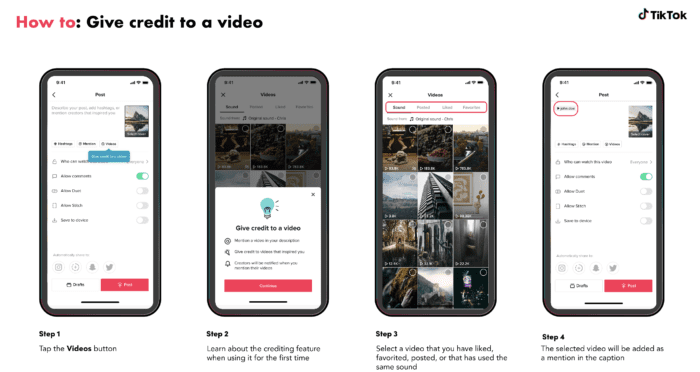TikTok Announces New Video Citation Tools

Yesterday, TikTok announced that it has launched new tools that it says will help creators better attribute original creators, including a tool that enables users to tag creators in the video’s caption, rather than just in the comments or description.
The idea is simple. TikTok users, when uploading a video, can tap the “Videos” button to give credit to another video on the site. The user will be free to select any video with the same sound or videos that the user liked, favorited or posted.
This process also works on videos already uploaded, simply by editing the video and going through the same motions as normal.
Once completed, the other video will be added as a mention in the video’s caption, giving the attribution a prominent place when compared to the description or comments.
In addition to providing the new tool, TikTok said that they will be providing additional prompts to encourage users to attribute original creators and education pop-ups that will explain the importance of attribution.

The move comes as part of a broader push for TikTok to create a “culture of credit”. Back in February, the company posted a guide on how to provide attribution on TikTok. This included text and video guides on why attribution is important, when to give credit to others and how to locate originators.
However, the series also noted some of the various challenges with attribution on TikTok, in particular trying to determine who the originator of a trend that is already extremely popular. TikTok encouraged users to try and do their best, but acknowledged that their suggestions were far from foolproof.
This move puts TikTok in an unusual position. The company is clearly trying to steer its user base toward normalizing attribution. However, it’s doing so in a way that is unique to any social media platform that came before it.
Creating a Culture of Credit
Attribution standards and methods typically come about in one of two ways:
- Top Down – Here, some central authority establishes the standards that they want to see used and expect users to follow it. This is largely the approach that Facebook has taken with its heavy use of “Share” buttons and baked-in attribution tools.
- Bottom Up – Here, users set the citation standards and norms and the centralized authority simply codifies them into the technology. This is what happened with Twitter, especially during the early years.
TikTok, however, is taking something of a hybrid approach. Their earlier guide on attribution mentions the use of tags that say DC, for Dance Credit, or MC, for Music Credit. These approaches were very much a “bottom up” standard, with users creating them and TikTok codifying them in their official guides.
However, the new tagging system, in particular with its popups encouraging attribution, is very much a “top down” approach. In fact, it’s entire “culture of credit” is a top-down approach to this problem, trying to change the norms on TikTok through a combination of communication and tools.
Why TikTok is ramping up these efforts now is likely tied, at least somewhat, to recent criticisms that the site is mishandling its most important creators. Unlike other sites, such as YouTube, which pays a percentage of earnings, TikTok pays creators from a flat Creator Fund. This means that, as TikTok grows, each view becomes worth less and less.
By pushing citation and attribution, TikTok is trying to put more attention on its originators, the small number of valuable creators that start the trends the site has become known for. By improving attribution, TikTok likely aims to keep those creators happier and more likely to both stay with the site and invest time into it.
This doesn’t make the move a bad thing. Ostensibly, improving attribution on TikTok literally helps everyone from originators to users to TikTok itself. The timing is interesting, even if the intentions are good.
Still, that timing may hinder the adoption of these norms, as trust of TikTok itself is relatively low with many users. That makes the future acceptance of these norms less certain, especially among users that are already jaded.
Bottom Line
To be clear, this move by TikTok is a very positive one. Adding new tools for attribution and citation is always a positive thing and the way TikTok added it is elegant and, when combined with the prompts, could go a long way to creating that culture of credit they want to form.
Furthermore, creating a culture of credit and attribution is a truly noble task. It’s one that helps support the creators that put the time, energy and resources into creating original content. While TikTok may be best known for its widely copied trends, a stronger culture of citation can help reward those that start them.
What is interesting to me about the story is that, for nearly all of its history, TikTok has been largely fine letting the users determine citation standards and methods. It’s only been within recent months that it’s taken this high level of interest in the issue.
Whether it feels the social norms haven’t progress fast enough or far enough, or they are simply seeking to improve relationships with creators, they are taking a very heavy interest in the subject now.
TikTok isn’t looking to enforce citation standards strongly, at least not at this time, but they are pushing strongly to change the culture around the issue.
How successful they are will depend heavily on TikTok users themselves and how quickly they do or do not embrace this new culture of credit.
Want to Reuse or Republish this Content?
If you want to feature this article in your site, classroom or elsewhere, just let us know! We usually grant permission within 24 hours.
